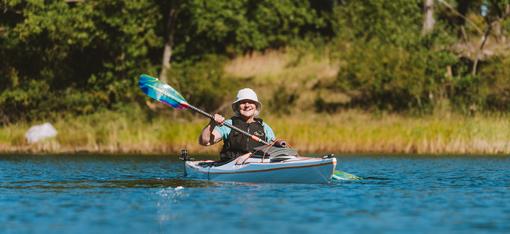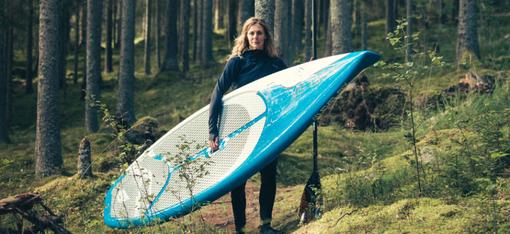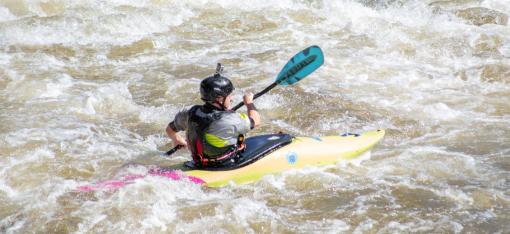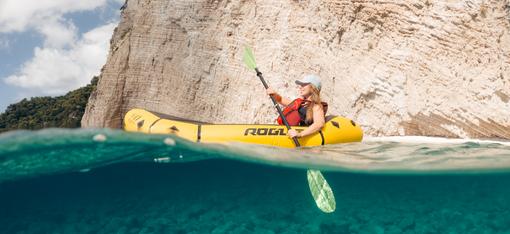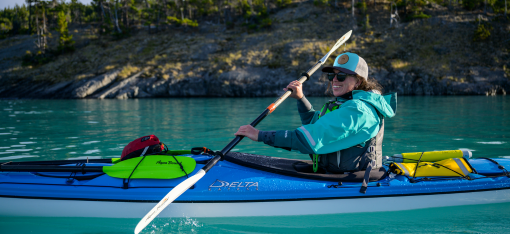How to Paddle a Tandem Kayak
5-minute read
A tandem kayak—a kayak built for two—can be a great way to get out on the water both for a recreational paddle and for a longer touring excursion.

Tandem kayaks can be the perfect solution for a variety of scenarios
Why Go Tandem?
There are many reasons why you might choose a tandem kayak over a solo one:
First, a tandem is a great way to introduce new paddlers to the sport of kayaking, especially if they’re also new to paddling. Going out in the same boat with an experienced paddler is sure to ease any first-time nervousness and make it more enjoyable.
Because tandems are so long, they’re also wider than a single kayak. That extra width provides comforting stability for those anxious about whether their boat will capsize. That’s a real fear for many inexperienced with paddling, and the tandem helps alleviate that fear.
Second, tandems are a wonderful way to take a non-paddler on a kayaking adventure. Maybe that non-paddler is your young child, an elderly parent or grandparent, or a dog or two.
Being lower to the water and using a double-bladed paddle, tandem kayaks are easier for the stern paddler to control than a tandem canoe. On calm days and in calm water, it’s entirely possible for one person to handle the kayak, especially if it’s a smaller, recreational sit-on model (more on that below).
Third, maybe you only have room to store and transport one kayak, but there are two of you. A tandem kayak might be the perfect solution over buying, transporting and storing two kayaks.
Buying one tandem is easier on your budget than buying two singles. And you only ever have to think about loading, tying down, transporting and storing one instead of two. So it could be a matter of simplicity.
Types of Tandem Kayaks
Tandem kayaks come in both sit-on-top and sit-inside models.
A sit-on-top tandem is great for recreational kayaking, the family cabin, and short excursions with your kids or dogs on flatwater and slow-moving rivers.

Sit-on-top tandem kayaks are ideal for families with young kids
Sit-ons are easy to enter and exit. And they make perfect swimming platforms for a child eager to jump into the water and climb back on while you’re out.
They’re wide and stable, which makes them almost impossible to capsize. And even if they do tip, they’re relatively easy to tip back upright and get back on. You won’t win any speed contests with a sit-on, but you’ll have a lot of fun!
Sit-inside tandems are ideal for touring, longer excursions (like multi-day trips) and big water.
Touring and sea tandems are designed to handle waves and some rough conditions while retaining their stability. They have bulkheads for storing gear and food, essential for safety and for (mostly) watertight cargo space. And they’re more efficient in the water than sit-on models, so you can cover more miles with the same amount of effort.

Guests use tandem sea kayaks for a Lake Superior multi-day kayak trip with an outfitter (photo courtesy of Sharon Brodin)
A wide variety of inflatable tandem kayaks is also available. These are mostly sit-ons or partial sit-in/sit-on. An inflatable is the perfect option if you don’t have space to store a 16-foot rigid boat or a vehicle big enough to haul it.
They are also usually more cost-effective and lighter in weight than solid boats.
Modern inflatables from reputable brands like Sea Eagle and Advanced Elements are well-made and can handle tough conditions, including your dog's nails.
No matter which of these types of kayaks you choose, be sure to pay attention to each one’s weight limit. Add the weight of yourself and your paddle partner, plus gear, to make sure you won’t exceed that limit. Going over the recommended weight makes a kayak less stable and more susceptible to capsizing.
Tandem Kayak Paddling Technique
Here are a few key points to keep in mind so your tandem kayak treks are as enjoyable as possible:
1. Paddle in unison. Not only will you avoid clashing your paddles, you’ll move along the water faster. It’s about developing your rhythm as a team.
2. Put the stronger paddler in the back. The stronger, more experienced paddler should sit in the back. That paddler is also responsible for steering. The front paddler will dictate the pace, which the rear paddler will match.
3. Turning your tandem kayak is a fun and easy skill to master. The front paddler employs the forward stroke, at the same time the back paddler uses a backward stroke on the opposite side. Voilà!
4. Tandems are wider and therefore very stable. While it’s unlikely to capsize, if you’re with someone who’s not a strong swimmer, it’s always a good idea to stick close to shore. And, of course, always wear your PFD.
Here’s a video from our friends at Paddle TV that covers these tips in a few short minutes:
Whether for a short jaunt around a lake, a long touring day on the ocean or a multi-day kayak trip, give the tandem a try! It just might become your favorite kayak.
[This was first published in 2017 and was updated in 2025]
What paddling questions can our friendly Customer Service team help you with? Contact us at 715-755-3405 or sales@aquabound.com, or choose our online chat option.
More for you...
-
Inflatable Kayaks 101: What to Know
-
All You Need to Know to Choose a Kayak Paddle
- Kayak Camping in Apostle Islands National Lakeshore, Wisconsin

